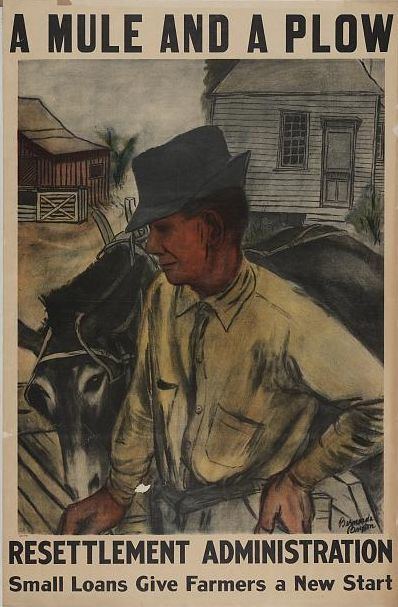Dissolved January 1, 1937 | ||
 | ||
Formed May 1, 1935 (1935-05-01) Agency executive Rexford G. Tugwell, Head | ||
The Resettlement Administration (RA) was a New Deal U.S. federal agency that, between April 1935 and December 1936, relocated struggling urban and rural families to communities planned by the federal government.
Contents
History
The RA was the brainchild of Rexford G. Tugwell, an economics professor at Columbia University who became an advisor to Franklin D. Roosevelt during the latter's successful campaign for the presidency in 1932 and then held positions in the United States Department of Agriculture. Roosevelt established the RA under Executive Order 7027, as one of the New Deal's "alphabet agencies", and Tugwell became its first and only head.
The new organization had four divisions: Rural Rehabilitation, Rural Resettlement, Land Utilization, and Suburban Resettlement.
However, Tugwell's goal of moving 651,000 people from 100,000,000 acres (400,000 km2) of agriculturally exhausted, worn-out land was unpopular among the majority in Congress. This goal seemed socialistic to some and threatened to deprive influential farm owners of their tenant workforce. The RA was thus left with enough resources to relocate only a few thousand people from 9,000,000 acres (36,000 km2) and build several greenbelt cities, which planners admired as models for a cooperative future that never arrived.
Relief camps for migrant workers
The main focus of the RA was to now build relief camps in California for migratory workers, especially refugees from the drought-struck Dust Bowl of the Southwest. This move was resisted by a large share of Californians, who did not want destitute migrants to settle in their midst.
The RA managed to construct 95 camps that gave migrants unaccustomed clean quarters with running water and other amenities, but the 75,000 people who had the benefit of the camps were a small share of those in need and even they could stay only temporarily. After facing enormous criticism for his poor management of the RA, Tugwell resigned in 1936. On January 1, 1937, with hopes of making the RA more effective, the Resettlement Administration was transferred to the Department of Agriculture through executive order 7530.
The Weedpatch Camp (also known as the Arvin Federal Government Camp and the Sunset Labor Camp) now on the National Register of Historic Places, was built in 1936 south of Bakersfield, California, not by the RA but the FSA (Farm Security Administration). The camp inspired John Steinbeck's 1939 novel, The Grapes of Wrath, a 1940 film adaptation directed by John Ford, a Tony Award-winning play and an opera.
Superseded by Farm Security Administration
In the face of Congressional criticism, in September 1937 it was folded into a new body, the Farm Security Administration (FSA), which operated until 1946.
Communities and greenbelt cities
The RA worked with nearly 200 communities on its projects, notably including:
Photography, film, and folk song projects
The RA also funded projects recording aspects of its work and context, including:
